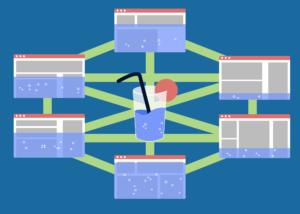Internal links are an essential element of your website’s structure and function for multiple reasons. Internal linking also appears in several forms, depending on how your site is set up. So, what is internal linking, how does it affect your website, and how can you create an effective interlinking strategy?
All of this and more will be tackled on this month’s Aroluxe Marketing blog.
The Basics of Internal Linking
What Is Internal Linking?
Internal links are links that when clicked lead users from one page on a domain to a different page on the same domain. The most common use for internal links is top menu navigation. For example, on our site, if you click on the About tab, you’ll quickly find yourself on our About page.
On top of menu navigation, internal linking can be used within your text as a hyperlink. Now, you don’t want to just copy and paste the link of your website onto a blog post or webpage. In fact, you shouldn’t. Hyperlinking is most effective when you create a hyperlink while using descriptive keywords in the anchor text.
If you’re not familiar with what anchor text looks like, here’s a link to one of our previous blogs as an example:
Is It Time For A Website Redesign?
Finally, another type of interlinking is using visual call-to-action elements to make your links more clickable.
Why Should I Use Internal Links?
To put it simply, if you don’t have internal links, then no users will ever find their way around your website. Furthermore, if your site’s pages don’t link to each other, then Google and other search crawlers won’t rank your site. After all, with no internal links, the crawler bots will only see one page, and nothing else.

Transfer Link Equity
Also known as “link juice,” link equity describes how follow links pass a certain amount of authority from one page to another. Link equity is more powerful when earning backlinks from other websites. Think of backlinks as upvotes for your website so it ranks higher in search results when Google sees them.
Also, if you have higher domain authority or page authority on one page of your website, you can pass a little authority onto other pages with effective interlinking strategies.
Link Hierarchy or Link Architecture
Internal links also establish the information hierarchy for your website. Information hierarchy is the structure of links organized by the relevance of your content to the user. If this sounds like Greek to you, think of it as ranking the most important pages for general users, down to the most specific pages your users need.
It’s like a tree.
Your site’s homepage should attract the most attention and then point users in different directions, or branches, depending on what they need.
For example, on our site, you may have found our main page by searching for marketing agencies in Brentwood, TN. But what you really wanted to find was someone to help you with your social media marketing, so you followed the link to our services and found our list of capabilities.
So, as you can see, internal links organize your site so your users find what they’re looking for.
How Do I Create an SEO-Friendly Link Structure?
To use another analogy, the best link structure should resemble a pyramid. That is, it should start with the broad links to top-level pages and then filter down to pages and posts optimized for long-tail keywords and calls to action.
When you publish a page or blog post, you should make sure to use it where possible according to your linking strategy. Links should also point to relevant pages, otherwise, Google will pass little to no authority to the linked page.
How Do I Create A Hyperlink?
There are a few ways to create a basic hyperlink in a website text editor.
- Highlight the anchor text you want to link, press command+k on MACOS or ctrl+k in Windows OS, paste the desired link and press enter.
- Highlight the text you wish to hyperlink, click the insert link button from the editor menu, paste your link and hit enter. Alternatively, you can also right-click the highlighted text and follow the same procedure.
- In your site’s text code editor, use manual HTML to create a link. Correctly formatted HTML links include an opening “a” tag, link location, anchor text, and a closing tag.
For important pages on your website, make sure that they are indexable through search engines. Depending on your website’s structure, code structure, or builder program, this setting may be either turned on or off by default.
Be aware that when publishing new pages or posts, they will need to be linked to other pages or posts. Your site may use auto-populating tools to handle this. Just make sure that your important content can be accessed through more than just a site search. If left orphaned, or unlinked, to other content, search engine spiders will not be able to find your content. As a result, your work can go unseen for who knows how long.

How Do I Use Nofollow Tags?
Sometimes, you may not want to pass link equity to certain pages on your website. A rel=”nofollow” attribute in a link tag tells the browser not to pass link juice to the linked page.
We use nofollow attributes to stop blog comment link spam from stealing authority from our client’s blogs. We also use nofollow to help search spiders focus on the most important and the newest pages on our client’s websites.
You can use various plugins to add nofollow attributes to your website, especially for groups of webpages. However, if you want to use nofollows on select links, then you can also add them into the link’s HTML code.
Potential Interlinking Pitfalls
If you’re including links in Java applications or third-party plugins, they may be inaccessible to search engines. If you’re using these applications for aesthetic purposes, make sure to include at least one hyperlink in the body text of your webpage.
If you have a page or pages featuring hundreds or thousands of links, keep in mind that search engine spiders usually stop crawling after around 150 links.
SEO Internal Linking Best Practices
A sophisticated internal linking structure provides SEO and user experience (UX) value for your website. Use these guidelines as you create and follow your own internal linking strategy.
Link Formatting and Placement:
- Organize web pages categorically based on keywords used in the link’s URL and anchor text.
- Improve user navigation by providing relevant and visually appealing links.
- Uses anchor text keywords to aid and take advantage of user intent.
- Organize your site structure so search engines recognize and rank your most important pages.
- Frequently update your links to promote ad campaigns with featured links on your home page and other key pages.
User Experience (UX):
- Design functional drop-down menus and navigation bars featuring links to key topical content to satisfy user intent.
- Provide clear labels for every link to encourage further website interaction, improve click-through rates, and improve SEO factors.
- Optimize anchor text for keyword rankings.
- Reduce overall linking depth to allow crawlers to reach every important page.
Link Authority:
- Add links to new web pages and blogs to high authority pages and posts to increase indexability and visibility of the new content.
- Optimize link placement by analyzing user intent to reduce bounce rate. This will show Google that the linked pages are relevant to users.

Site Architecture:
- Structure your links like a pyramid. Home page at the top, next lay the key content pages, next are the next most relevant pages and so on down to your deep pages.
- Focus on reducing the number of links between a landing page and conversion or key product pages.
- As your side grows, use your site’s navigation features, menu structure, submenus, categories, posts pages, post tags, and featured links to ensure no page is deeper than three clicks.
Content Links:
- Placing content links to relevant articles tells your readers they can stop reading the current page. Be aware of this and include essential calls to action before these links.
- Bolding content links makes them visually stand out from the rest of the content and usually attracts more clicks. Place links in blog posts to other relevant blog posts, service pages, or product pages. Relevancy is key because irrelevant links will disrupt your UX and increase your bounce rate.
Hyperlink On-Page Positioning:
- The position of an internal link is irrelevant from an SEO standpoint but is not from a user experience standpoint. Place content links where you anticipate users will find them the most valuable.
- Place your most important internal links on your home page, in the navigation bar, or on a drop-down menu.
- Don’t link back to your home page or contact page within your content. Only include links to relevant posts within main body content.
- Footer links and sidebar links should link to relevant content or product pages.
- Place links at the end of articles or on a sidebar to relevant web pages to encourage users to keep interacting with your website.
Link Relevancy:
- Optimize all anchor text to reflect the title or topic of the linked page.
- Be sure to create keyword variations for your anchor text structure. Constantly using the same anchor text for each link could qualify as spam, keyword stuffing, or keyword cannibalization which will decrease your search rankings.
- Include at least three internal links for a piece of content. Longer pieces of content can include more links.
Call-To-Action Links:
- Optimizing your call to action (CTA) links to maximize your conversion rate. Emphasize and optimize CTA button design so they display properly on all devices.
- Include CTAs on each web page to create more opportunities for user conversions.
Conclusion
We hope this guide to interlinking has helped you understand the dos and don’ts. Keep in mind that web design and SEO are highly situational and nuanced fields. So, what works for one website or company may not work for another.
If you’re looking for someone to optimize your site’s internal linking architecture, reach out to us. Let’s start a conversation about how we can help you get more traffic, improve your UX, and see more results.

